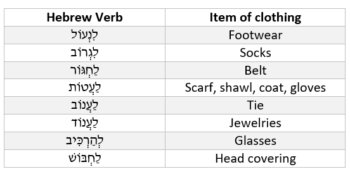Hebrew Verbs for Dressing Posted by Ayana on Nov 23, 2021 in Vocabulary
The Hebrew language becomes very specific when it comes to dressing up. It has several verbs for all the clothing items that cover our body. These verbs are not antonyms, because each refers to specific clothing items. It’s a long list, let’s start from head to toe:
לַחְבֹּושׁ (pronounced as lach-bosh) refers to head covering only. It can be used with any kind of hat or cap, including helmet and kippah. For example:
עַל אוֹפַנּוֹעַ חוֺבְשׁׅים קַסְדָּה.
On a motorcycle wear a helmet.
הוּא חָבַשׁ כִּפָּה וְיָצָא לַבֵּית כְּנֶסֶת.
He wore a kippah and went out to the synagogue.
אֲנׅי תָּמִיד עׅם כּוֹבַע: בַּקַּיׅץ אֲנׅי חוֺבֶשֶׁת כּוֹבַע קַשׁ, בַּחוֺרֶף כּוֹבַע צֶמֶר.
I always wear a hat: in summer I wear a straw hat, in winter a woolen hat.
—————————————————————————————————————————
לְהַרְכִּיב (pronounced as le-ar-kiv) refers to glasses only. Morphologically the verb has no connection to the Hebrew noun for glasses מִשְׁקָפַיִם, but somehow it became the specific verb to use when using glasses or sunglasses. For example:
אֲנׅי מַרְכּׅיב מִשְׁקָפַיִם רַק כְּשֶׁאֲנׅי נוֺהֵג.
I only wear glasses when I drive.
הַיֶּלֶד מְסָרֵב לְהַרְכִּיב מִשְׁקָפַיִם.
The child refuses to wear glasses.
—————————————————————————————————————————
לַעֲנֹוד (pronounced as la-a-nod) refers to any piece of jewelry, including a wrist watch. You can לַעֲנֹוד earrings on your eras, necklace on your neck, bracelet on your wrist, a ring on your finger. For example:
אֶת שַׁרְשֶׁרֶת הַזָּהָב אֲנׅי עוֺנֶדֶת בְּאֵירוּעׅים מְיֻחָדִים.
I wear the gold necklace on special occasions.
לֺא כֻּלָּם עוֺנְדּים אֶת טַבַּעַת הַנִּשּׂוּאִין שֶׁלָּהֶם.
Not everyone wears their wedding ring.
—————————————————————————————————————————
לַעֲנֹוב (pronounced as la-a-nov) refers to ties only. It comes from the Hebrew noun for tie עֲנִיבָה. When talking about a tie, however, there is one more general verb that can be used: לִקְשֹׁור. לִקְשֹׁור means to tie, to knot, and it doesn’t exclusively belong to the semantic field of clothing. It refers to any kind of knot. For example:
אַבָּא שֶׁלׅי לִמֵּד אוֺתׅי לִקְשֹׁור עֲנִיבָה.
My dad taught me how to tie a tie.
מֵעוֹלָם לֺא עָנַבְתִּי עֲנִיבָה.
I never wore a tie.
—————————————————————————————————————————
לַעֲטוֹת (pronounced as la-a-tot) refers to clothing items that are wrapped around the neck or shoulders. The verb can be used with scarf, shawl, coat, etc. It is also used with gloves. לַעֲטוֹת (meaning to wrap) is not so common in spoken language, it is typically only written language.
הוּא עָטָה עַל עַצְמוֺ צָעִיף וְיָצָא הַחוּצָה.
He wrapped a scarf and went out.
כְּשֶׁאֲנׅי מְשַׂחֵק בַּשֶׁלֶג אֲנׅי עוֺטֵה כְּפָפוֹת.
When playing in the snow I wear gloves.
—————————————————————————————————————————
לַחְגּוֹר (pronounced as lach-gor) refers to belt only. It comes from the Hebrew noun for belt חֲגוֹרָה. For example:
אֲנׅי תָּמִיד חוֺגֵר חֲגוֹרָה כְּשֶׁאֲנׅי מׅתְלַבֵּשׁ לָעֲבוֹדָה.
I always wear a belt when I dress for work.
מֻמְלָץ לַחְגּוֹר אֶת הַחֲגוֹרָה עַל הַחֵלֶק הֲכׅי צַר בַּגּוּף.
It is recommended to wear the belt on the narrowest part of the body.
—————————————————————————————————————————
לִגְרֹוב (pronounced as lig-rov) refers to socks only. It comes from the Hebrew noun for socks גַּרְבַּיׅים. For example:
גְּרֹב גַּרְבַּיׅים, הָרִצְפָּה קָרָה.
Wear socks, the floor is cold.
גָּרַבְתִּי אֶת הַגַּרְבַּיׅים שֶׁקִבַּלְתִּי מַתָּנָה.
I wore the socks I received as a gift.
—————————————————————————————————————————
לִנְעֹול (pronounced as lin-ol) refers to footwear only. It comes from the Hebrew noun for shoes נַעֲלַיִים, but refers to any kind of footwear: shoes, boots, sandals, flip-flops, slippers, etc. For example:
נָעַלְתִּי נַעֲלַיִים וְיָצָאתִי הַחוּצָה.
I put on my shoes and went out.
הַיֶּלֶד נוֹעֵל לְבַד נַעֲלַיִים כְּבָר מׅגּׅיל שָׁלוֹשׁ.
The child wears shoes on his own from the age of three.
—————————————————————————————————————————
The next chart summarizes the above verbs:

There are two more verbs that are mainly used when referring to items of clothing: לִלְבֹּושׁ and לָשׂׅים.
לִלְבֹּושׁ (pronounced as lil-bosh) means to wear. It is the regular verb for clothing. It can be used with any piece of wearing: shirt, pants, dress, suit, and so on. It can also be used with the items that are already included in our post, and have a specific verb of themselves. לָשׂׅים (pronounced as la-sim) means to put on. It is also can be used with any kind of piece wearing. For example:
לֺא רָצׅיתׅי שׂׅמְלָה, לָבַשְׁתּׅי מׅכְנָסַיׅים הַיּוֺם.
I didn’t want a dress, I wore pants today.
אֲנׅי חַיָּיב לׅלְבּוֺשׁ צָעִיף, אַחֶרֶת הַצַּוָּואר שֶׁלּׅי קוֺפֵא.
I must wear a scarf, otherwise my neck freezes.
שׂׅים מְעׅיל וּבוּא אׅיתׅי.
Put on a coat and come with me.
מָה תִּלְבְּשִׁי לַמְּסִיבָּה?
What will you wear to the party?
Keep Calm and Learn Hebrew

Build vocabulary, practice pronunciation, and more with Transparent Language Online. Available anytime, anywhere, on any device.






Comments:
Bob MacDonald:
It remains fascinating for me how different Modern Hebrew is from Biblical Hebrew. I wrote a slight piece on this around the prefix ּw (shin) just a few days ago. Most recently I am switching from square text to Simulated Hebrew (full spelling of Hebrew in Latin characters). This fully developed approach to transliterating Hebrew may turn out to eliminate both rtl and its technical issues and learning other shapes for sounds. I’ll tell you more in a year or so. If there is interest, note this new publication: The SimHebrew Bible: The Hebrew Bible in Simulated Hebrew – with English Guide.
Bob MacDonald:
I neglected to put in the address for the piece on changing patterns in language. It is here https://meafar.blogspot.com/2021/11/what-shows-change-in-language.html